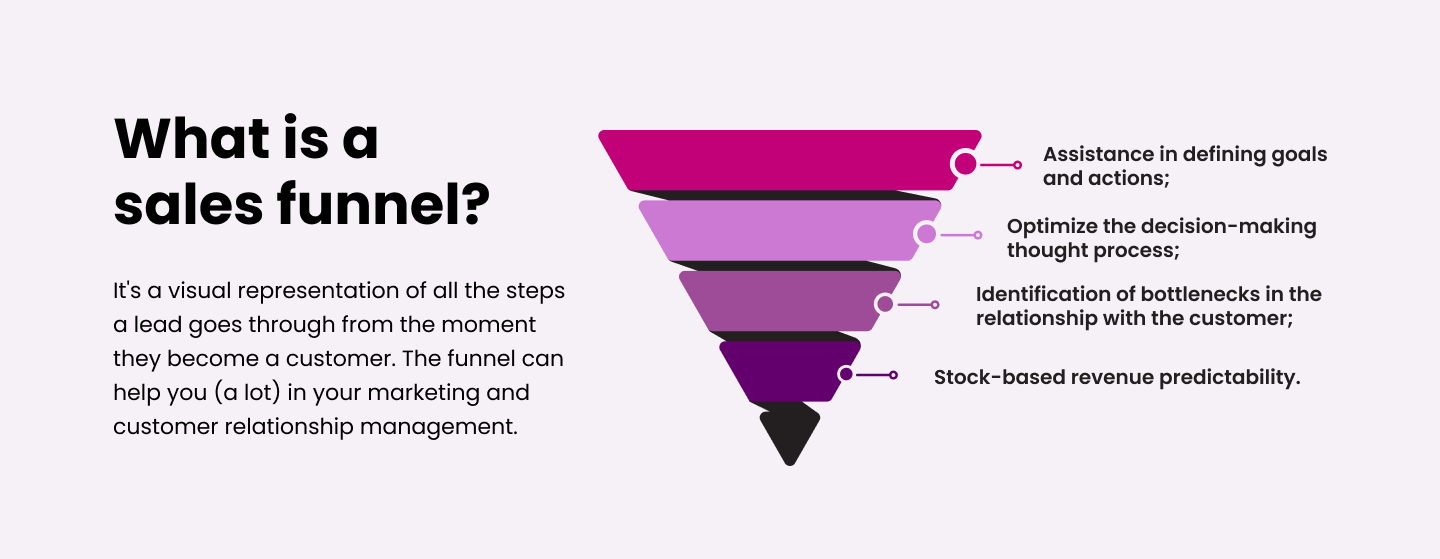We are used to having a marketing sector and a sales sector, each operating under its own rules, which generates a marketing funnel and a sales funnel. But are the concepts really that different?
What you will see in this post:
- The marketing funnel
- The sales funnel
- Marketing's work
- Marketing funnel and sales funnel = conversion funnel
Although we are talking about a funnel in both cases, the structure may be similar, but when we enter each stage, the strategies are different (and at the same time complementary).
Anyone who has already learned the importance of integrating these two sectors has understood that the important thing is to have a single funnel, or pipeline. At each stage of this funnel, an approach comes in, sometimes marketing, sometimes sales,and it is our job as a marketing team to identify the moment in which our lead/client is and act with a focus on their needs.
A good sales and loyalty process uses the best practices of both funnels in a complementary and interdependent way, this dependence allows you to have a broader view of the consumer journey. This vision allows you to be able to work on situations in a timely manner even before the lead itself identifies a need itself.
The marketing funnel
The famous marketing funnel, is a result of Inbound Marketing and is nothing more than translating the consumer's journey into different stages, understanding what our leads' difficulties are and thus providing them with the necessary solutions at the exact moment.
With the evolution of digital strategies, the marketing funnel has incorporated technologies such as marketing automation and artificial intelligence to personalize communication and increase efficiency in lead nurturing.
That is, the objective of the marketing funnel is to attract visitors through actions and content with the aim of converting them into leads. Any resemblance to the flywheel you may have seen in inbound strategies is not mere coincidence! These two tools go hand in hand when it comes to attracting and capturing leads.
The funnel is divided into three stages:
- ToFu: you have a wide audience, formed by all those that your educational institution considers candidates for a vacancy. Here, it's the moment of attraction! where you generate actions and content that call your potential lead's attention so that he gets to know you better and at some point, becomes aware that he has a "pain".
- MoFu: people interested in what education can offer. That is, at that moment, the lead already knows that he needs your product in the educational area, and you need to nurture this lead with relevant content for him to advance in the purchase journey.
- BoFu: are those who are really interested in enrolling and being in the classroom. It's time to sell! Here you need to offer your best business strategy so that your lead becomes a student.

Read too:
- The importance of CRM and marketing automation for all stages of the funnel;
- Your educational institution is ready to scale enrollments;
- Inbound Marketing: 7 metrics to track and optimize;
- 5 good practices of relationship flow with students.
The sales funnel
Between the middle and bottom of your marketing funnel, the work of theSales team, but that doesn't mean marketing's work is over. And this is where the confusion usually appears!
Integration between marketing and sales teams, known as 'smarketing', has proven essential to optimize the conversion of leads into registrations, ensuring aligned and effective communication.
While the sales team takes a commercial approach, highlighting benefits such as discounts on enrollments, gifts for the first 100 enrollees and scholarship draws, marketing continues doing what it does best: educating, making its leads aware of the importance of studies.
From now on, the work of convincing is done together. After enrollment, marketing becomes more active again, employing loyalty strategies.
Marketing's work
There are those who think that "SMarketing” is a smart marketing strategy. However, it is a combination of sales. It is marketing, building an integrated perspective of these two sectors.
Although it is not an easy task, it is necessary to focus on the common good: sales and loyalty. These two things are only possible when the customer contact areas work in an integrated manner, respecting the stages of each process.
It is always good to remember that these two areas have in common the objective of selling more and better, generating profit for the company.
When your educational institution understands that there is no linear path in the consumer journey, it begins to understand that the joint action of these two sectors forms a single conversion funnel.
There are leads that arrive completely unprepared for conversion, requiring greater marketing work. Others, in turn, are already decided, just choosing the best educational institutions, demanding proactive sales.
There are also those who are in the middle of the path or go back and forth on the journey of decision. In this case, joint work is even more necessary. Sales can't pressure the lead to convert and marketing can't let it go backwards.
Marketing funnel and sales funnel = conversion funnel
Our final tip is: build your conversion funnel, integrating marketing and sales activities so that they contribute to speeding up the process. It requires understanding and synergy between these two teams; a shared understanding of who the educational institution's audience is and a clear vision of where each person's work begins and ends.
Furthermore, the use of an educational CRM can facilitate this integration, providing a unified view of the relationship with the potential student and helping to identify opportunities for improvement in the recruitment process.
It is also important to eliminate the common barriers that bring these sectors into conflict, such as differences in goals and objectives. The aim is to make everyone work towards the same result: enroll and grow in.
And since we are talking about registrations, how about getting to know some educational marketing strategies for colleges?
Marketing funnel vs. Sales funnel: Key questions and answers for your educational institution
What’s the difference between a marketing funnel and a sales funnel?
The marketing funnel focuses on attracting and nurturing leads through content and engagement, while the sales funnel focuses on converting those qualified leads into enrollments. The stages may look similar, but the actions are different — and complementary.
Do marketing and sales really need to work together?
Absolutely. The most effective approach is to have a single conversion funnel, where both marketing and sales collaborate, each taking the lead at different moments. This ensures a smoother journey and higher conversion rates.
What are the stages of the marketing funnel?
-
ToFu (Top of the Funnel): Awareness stage. You attract potential students through relevant content and actions.
-
MoFu (Middle of the Funnel): Consideration stage. Leads know they need your solution — now it’s time to nurture them.
-
BoFu (Bottom of the Funnel): Decision stage. These are leads ready to enroll — it’s time for your best sales strategy.
When does the sales funnel come into play?
Between the middle and bottom of the marketing funnel. That’s where the sales team steps in with personalized offers, discounts, scholarships, and persuasive arguments to close the enrollment — but always in sync with marketing.
What is smarketing?
Smarketing is the integration of sales and marketing teams, aligning strategies and communication to convert leads more efficiently. It's about teamwork, shared goals, and a unified vision of the student journey.
Why is it important to align marketing and sales efforts?
Because student behavior isn’t linear. Some leads need more time and content; others are ready to enroll right away. An aligned team can better identify each case and act accordingly, increasing the chances of successful recruitment.
Can marketing and sales use the same funnel?
Yes — and they should. A shared conversion funnel gives both teams a complete view of the lead journey. It prevents miscommunication, improves timing, and boosts results at every stage.
How does a CRM help with this integration?
CRM centralizes all lead interactions and history, helping both teams understand where each prospect is in the journey. Tools like educational CRMs allow for better timing, personalization, and coordination between marketing and sales.
What’s the main goal of having a shared funnel?
To make everyone — marketing and sales — work together toward the same goal: increasing enrollments. By removing internal silos and aligning strategies, your institution becomes more efficient and student-focused.
































